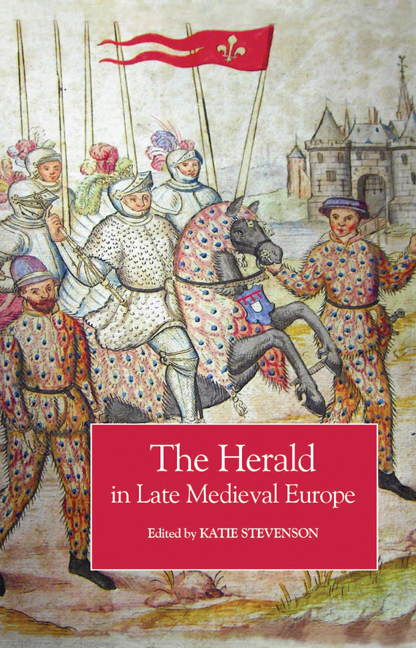Book contents
- Frontmatter
- Contents
- List of Illustrations
- Notes on Contributors
- Acknowledgements
- Abbreviations
- 1 Introduction
- 2 The Development of the Office of Arms in England, c. 1413–1485
- 3 Ancient Precedent or Tudor Fiction? Garter King of Arms and the Pronouncements of Thomas, Duke of Clarence
- 4 Jurisdiction, Authority and Professionalisation: The Officers of Arms of Late Medieval Scotland
- 5 The March of Brittany and its Heralds in the Later Middle Ages
- 6 City Heralds in the Burgundian Low Countries
- 7 King of Arms of the Ruwieren: A Special Function in the German Empire
- 8 Heraldry, Heralds and Politics in the Republic of Florence in the Late Middle Ages
- 9 Tournaments, Heraldry and Heralds in the Kingdom of Poland in the Late Middle Ages
- 10 A time when ‘fools and dwarfs were highly esteemed’? Seeking the Late Medieval Scandinavian Herald
- Index
4 - Jurisdiction, Authority and Professionalisation: The Officers of Arms of Late Medieval Scotland
Published online by Cambridge University Press: 26 October 2017
- Frontmatter
- Contents
- List of Illustrations
- Notes on Contributors
- Acknowledgements
- Abbreviations
- 1 Introduction
- 2 The Development of the Office of Arms in England, c. 1413–1485
- 3 Ancient Precedent or Tudor Fiction? Garter King of Arms and the Pronouncements of Thomas, Duke of Clarence
- 4 Jurisdiction, Authority and Professionalisation: The Officers of Arms of Late Medieval Scotland
- 5 The March of Brittany and its Heralds in the Later Middle Ages
- 6 City Heralds in the Burgundian Low Countries
- 7 King of Arms of the Ruwieren: A Special Function in the German Empire
- 8 Heraldry, Heralds and Politics in the Republic of Florence in the Late Middle Ages
- 9 Tournaments, Heraldry and Heralds in the Kingdom of Poland in the Late Middle Ages
- 10 A time when ‘fools and dwarfs were highly esteemed’? Seeking the Late Medieval Scandinavian Herald
- Index
Summary
THE CURRENT UNDERSTANDING of the history of the officers of arms in Scotland has been shaped predominantly by heralds themselves. These heraldic historians – especially those of the nineteenth and early twentieth centuries – have often been ill-equipped to handle source material from the medieval and early modern periods, and have tended both to misinterpret late medieval evidence and to read anachronistically into the past their own contemporary heraldic organisation and function. Much of what passes for evidence in these histories is apocryphal and derived from the folklore of the modern Court of the Lord Lyon. One need only open the pages of some of the key works, such as Stevenson's Heraldry in Scotland, Balfour Paul's Heraldry in Relation to Scottish History and Art and Grant's Court of the Lord Lyon, to find that there are often crucial absences of references or that the notes refer only to a small selection of equally poorly referenced secondary works. In a sense, of course, they were simply compounding the errors of an earlier generation of heralds, who were not above fabricating evidence to fill inconvenient lacunae. For example, Roderick Lyall states that Sir James Balfour of Denmilne, Lyon King of Arms from 1630, ‘was sometimes baffled by the medieval materials he found and it seems clear that he was not above inventing documents to cover gaps in his evidence’. By its very nature, of course, heraldry involves the presentation of a vast range of fabricated materials, particularly by those wishing to prove the authenticity of a spurious or badly supported claim to arms. Coupled with notoriously sparse Scottish medieval sources, it is no wonder that modern heralds have been unable to interpret fully their own past.
However, in the absence of genuinely scholarly and interpretive accounts, it is unfortunately the very worst offenders who have been incorporated into the historical canon. Perhaps the most serious criticism that can be levied against these antiquarian scholars is that they have established a very partial picture of medieval heralds and underestimated their significance by only seeking to answer questions related to the powers that heralds have held since the nineteenth century.
- Type
- Chapter
- Information
- The Herald in Late Medieval Europe , pp. 41 - 66Publisher: Boydell & BrewerPrint publication year: 2009



